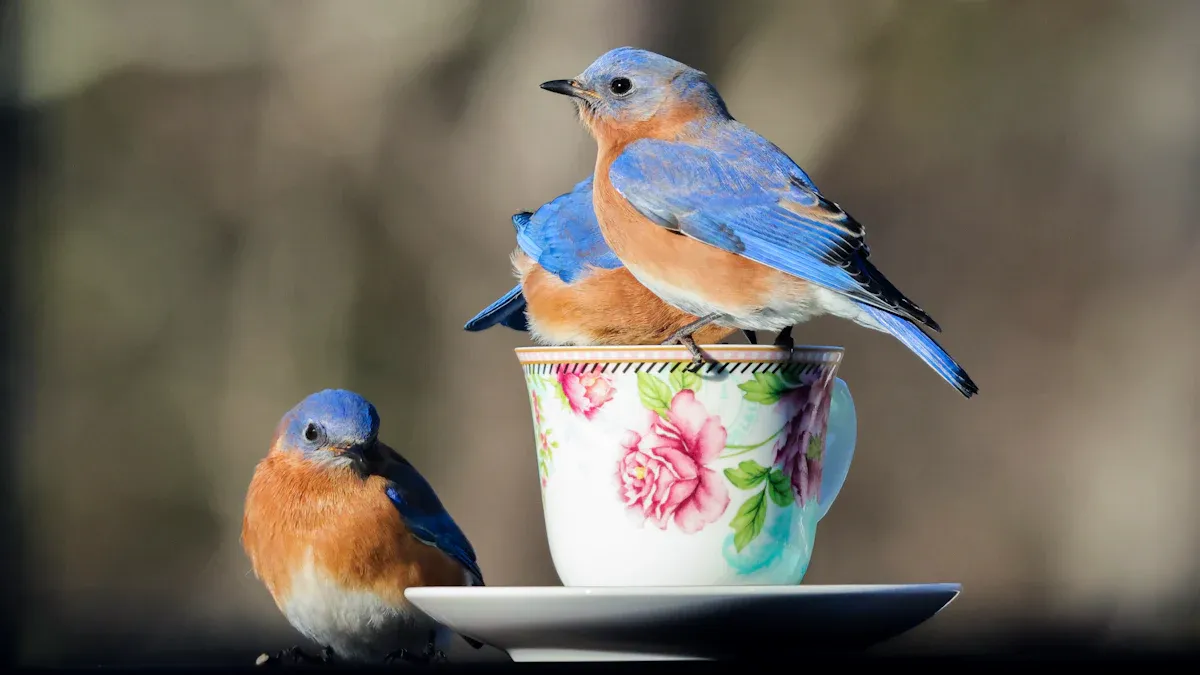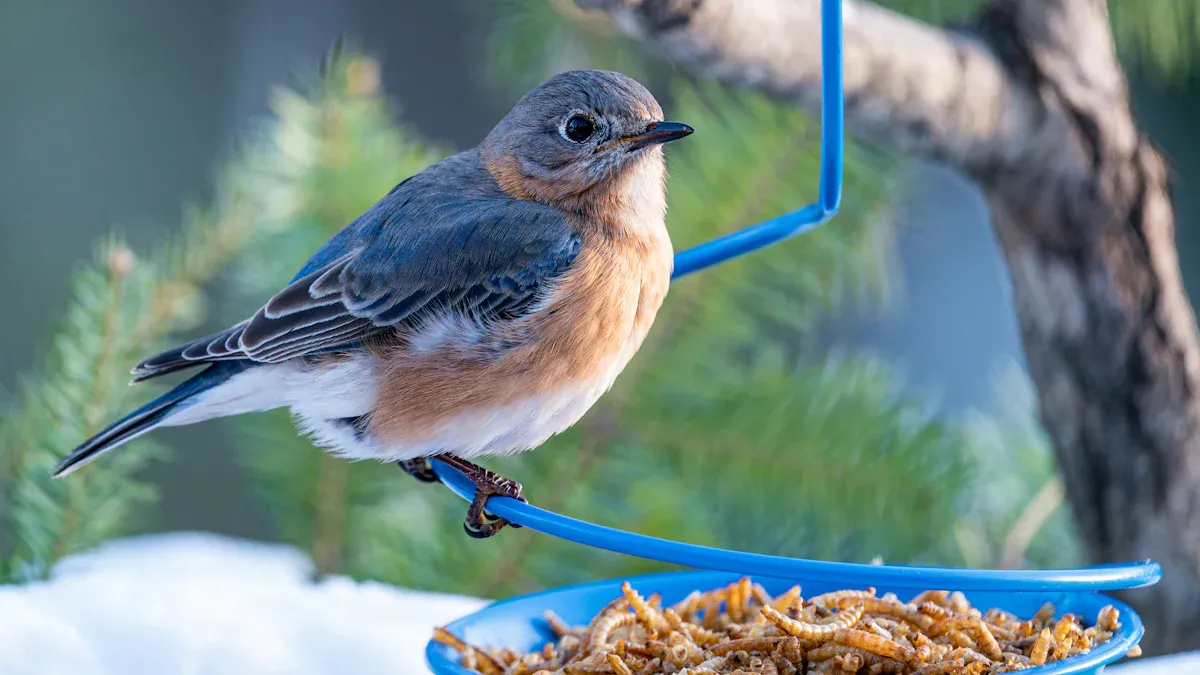
Dried mealworms for bluebirds are a simple way to attract these beautiful birds to your yard. They’re packed with nutrients that support bluebird health and are easier to handle than live ones. According to Emma Greig from Project FeederWatch, feeding birds fosters a connection with nature and encourages species like bluebirds to visit. Offering mealworms for bluebirds near nests can even help young bluebirds thrive during tough weather. Responsible feeding ensures these stunning birds stay healthy while brightening your outdoor space.
Key Takeaways
- Dried mealworms are healthy for bluebirds. They give protein and energy, which helps during nesting and bad weather.
- Feed bluebirds carefully by giving around 15 mealworms each day. Change the amount based on weather and how many birds come.
- Use a hopper feeder to bring in bluebirds. It keeps bigger birds away and makes feeding safe.
Why Mealworms For Bluebirds Are Beneficial
Nutritional Value of Mealworms
Mealworms are a powerhouse of nutrients that bluebirds need to thrive. Packed with 21.32% protein and 12.72% fat, they provide the energy bluebirds require, especially during demanding times like nesting or migration. Their fiber content (1.73%) supports digestion, while essential minerals like calcium and phosphorus promote strong bones and healthy development. Although the calcium-to-phosphorus ratio is low, mealworms remain an excellent supplement to a balanced diet. Bluebirds benefit greatly from this clean, nutrient-rich food source, making mealworms a favorite among bird enthusiasts.
Seasonal Benefits of Feeding Mealworms
Mealworms shine as a food source during specific seasons. In winter, when natural food is scarce, they offer a reliable source of energy to help bluebirds survive harsh conditions. Observations show that bluebirds actively consume mealworms in colder temperatures, such as 18°F. During the breeding season, mealworms support the growth of nestlings and help adult bluebirds meet the energy demands of feeding their young. By reducing the time spent foraging, mealworms allow bluebirds to conserve energy, which is crucial during extreme weather or emergencies.
Convenience for Bird Enthusiasts
For bird lovers, mealworms are a practical and rewarding choice. Dried mealworms are easy to handle and store, making them a convenient option compared to live ones. They withstand various weather conditions and can be placed in feeders to attract bluebirds. With a little patience, bluebirds can even be trained to visit feeders regularly, creating a delightful interaction for enthusiasts. Offering mealworms for bluebirds not only supports their health but also enhances the joy of birdwatching.
How to Feed Mealworms For Bluebirds

Step-by-Step Feeding Guide
Feeding bluebirds with mealworms can be a simple and enjoyable process. Follow these steps to get started:
- Store mealworms properly: Keep dried mealworms in a cool, dry place to maintain their freshness. If using live mealworms, store them in a refrigerator in a secure container with bedding and a small amount of food.
- Choose the right feeder: Use a hopper-style feeder with small entry holes to ensure only bluebirds can access the mealworms. Place the feeder at least 100 feet away from nest boxes to keep predators at bay.
- Offer the right amount: Start with about 15 mealworms per bluebird daily. Adjust the quantity based on weather conditions or the number of birds visiting.
- Feed at the right time: Offer mealworms twice a day, preferably in the morning and late afternoon. This ensures bluebirds get their share before other birds.
Tip: If you’d like to hand-feed bluebirds, try using a blue cloth and a shallow pan of mealworms to attract their attention. Be patient and consistent for the best results.
Tips for Portion Sizes and Feeding Frequency
Mealworms for bluebirds should be offered in moderation. While they are high in protein, they don’t provide complete nutrition. A good rule of thumb is to use about 100 mealworms per day once bluebirds become regular visitors. Feeding smaller portions twice daily prevents overfeeding and ensures the birds stay healthy.
Note: Overfeeding can lead to health issues for both adult and young bluebirds. Always aim for balance when offering mealworms as a treat.
Should You Soak Dried Mealworms?
Soaking dried mealworms can make them more appealing to bluebirds. To do this, place the mealworms in lukewarm water for about 15 minutes before serving. This softens them, mimicking the texture of live mealworms. Another option is to soak them in a few drops of vegetable oil, which can enhance their attractiveness.
Tip: Soaking mealworms is especially helpful during the breeding season, as it makes them easier for young bluebirds to digest.
Feeding Responsibly and Avoiding Risks
Preventing Overfeeding
Overfeeding bluebirds can lead to health problems and disrupt their natural foraging habits. To avoid this, follow these simple guidelines:
- Offer about 15 mealworms per bluebird daily.
- Feed them once or twice a day, depending on the weather. Poor conditions may require more frequent feeding.
- Monitor the number of birds visiting your feeder and adjust portions accordingly.
Supplemental feeding can benefit bluebirds, especially during nesting or harsh weather. However, moderation is key. A balanced approach ensures they get the nutrition they need without becoming overly dependent on human-provided food.
Tip: Use a hopper-style feeder to control portions and prevent waste.
Addressing Calcium Deficiency
Mealworms are a great treat, but they lack sufficient calcium, which is essential for bluebirds. Calcium deficiency can cause weak bones in young birds or egg-binding in females. To address this, coat mealworms with calcium carbonate or calcium citrate powder before feeding. This simple step helps balance their diet and supports healthy development.
Note: Calcium supplementation is especially important during the breeding season when females need extra nutrients for egg production.
Ensuring a Balanced Diet
While mealworms for bluebirds are nutritious, they should only be part of a varied diet. Bluebirds thrive on a mix of insects, berries, and other natural foods. To ensure a balanced diet:
- Soak dried mealworms in water to provide hydration and soften their texture.
- Offer fresh fruits like blueberries or chopped apples alongside mealworms.
- Avoid feeding only mealworms for extended periods.
A diverse diet keeps bluebirds healthy and encourages natural foraging behaviors. By feeding responsibly, bird enthusiasts can enjoy the beauty of bluebirds while supporting their well-being.
Practical Tips for Feeders and Storage
Choosing the Best Feeder for Bluebirds
Selecting the right feeder can make a big difference in attracting bluebirds. Hopper-style feeders are a great choice because they allow bluebirds to feed without competition from larger birds. These feeders often have small entry holes, which help keep unwanted visitors out. Users also appreciate feeders made from smooth materials like glass or plastic, as they’re easier to clean.
To ensure safety, choose feeders with multiple exits so birds don’t get trapped. Adding Plexiglas sides with markings can help bluebirds navigate the feeder more easily. For best results, place the feeder in a quiet area of your yard, away from heavy foot traffic or predators.
Tip: Feeders designed specifically for bluebirds, offering foods like mealworms and jelly, tend to be the most effective.
Proper Storage of Dried Mealworms
Storing dried mealworms correctly keeps them fresh and safe for bluebirds. Airtight containers work best to prevent moisture and pests from spoiling the mealworms. For long-term storage, keeping them in a refrigerator or freezer is highly recommended. This helps maintain their quality and prevents rancidity caused by heat.
If you prefer to store them at room temperature, ensure the bag is sealed tightly and kept in a cool, dark place. Avoid exposing mealworms to light, as it can degrade their quality over time.
Note: Proper storage not only preserves the mealworms but also ensures bluebirds receive a healthy treat.
Protecting Mealworms From Pests and Moisture
Pests and moisture can ruin your supply of dried mealworms. To avoid this, always use airtight containers. Storing them in a freezer or refrigerator adds an extra layer of protection. If you’re storing them outside, choose steep-sided containers to prevent pests from climbing in.
Maintaining the right temperature is also important. Mealworms stored at around 38ºF stay fresh longer, while those kept at 23ºF can last up to 80 days without spoiling.
Tip: Regularly check your storage containers for signs of pests or moisture to ensure your mealworms remain in top condition.
Feeding mealworms for bluebirds offers a simple way to attract these vibrant birds while supporting their health. Mealworms provide essential nutrients, especially during nesting or harsh weather. Observations show that offering mealworms can help nestlings survive and grow stronger. Responsible feeding practices, like portion control and balanced diets, ensure bluebirds thrive naturally.
Why not start today? Place mealworms in a visible feeder and watch as bluebirds brighten your yard. With a little care, you’ll enjoy their beauty while helping them flourish.
FAQ
How can I attract bluebirds if they don’t visit my feeder?
Place the feeder in a quiet spot near trees or shrubs. Add a small dish of water nearby. Patience and consistency will encourage bluebirds to visit. 🐦
Can I feed bluebirds other foods besides mealworms?
Yes! Bluebirds enjoy fruits like blueberries, raisins, and chopped apples. Offering a mix of foods ensures they get a balanced diet and stay healthy.
What should I do if other birds eat all the mealworms?
Use a bluebird-specific feeder with small entry holes. This design keeps larger birds out while allowing bluebirds to access the mealworms easily.
Tip: Place the feeder away from high-traffic areas to reduce competition.


